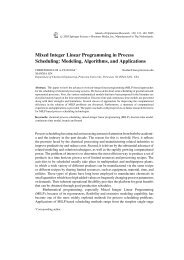Conceptual framework: What do you think is going on?
Conceptual framework: What do you think is going on?
Conceptual framework: What do you think is going on?
You also want an ePaper? Increase the reach of your titles
YUMPU automatically turns print PDFs into web optimized ePapers that Google loves.
03-Maxwell.qxd 10/1/2004 3:13 PM Page 42<br />
42 QUALITATIVE RESEARCH DESIGN<br />
I’m using the term “theory” to refer to something that <str<strong>on</strong>g>is</str<strong>on</strong>g> c<strong>on</strong>siderably<br />
broader than its usual meaning in d<str<strong>on</strong>g>is</str<strong>on</strong>g>cussi<strong>on</strong>s of research methods. By<br />
“theory,” I mean simply a set of c<strong>on</strong>cepts and the proposed relati<strong>on</strong>ships<br />
am<strong>on</strong>g these, a structure that <str<strong>on</strong>g>is</str<strong>on</strong>g> intended to represent or model something<br />
about the world. As LeCompte and Pre<str<strong>on</strong>g>is</str<strong>on</strong>g>sle (1993, p. 239) stated, “theorizing<br />
<str<strong>on</strong>g>is</str<strong>on</strong>g> simply the cognitive process of d<str<strong>on</strong>g>is</str<strong>on</strong>g>covering or manipulating abstract categories<br />
and the relati<strong>on</strong>ships am<strong>on</strong>g these categories.” My <strong>on</strong>ly modificati<strong>on</strong><br />
of th<str<strong>on</strong>g>is</str<strong>on</strong>g> <str<strong>on</strong>g>is</str<strong>on</strong>g> to include not simply abstract categories, but c<strong>on</strong>crete and specific<br />
c<strong>on</strong>cepts as well.<br />
Th<str<strong>on</strong>g>is</str<strong>on</strong>g> use encompasses everything from so-called “grand theory,” such as<br />
behavior<str<strong>on</strong>g>is</str<strong>on</strong>g>m, psychoanalys<str<strong>on</strong>g>is</str<strong>on</strong>g>, or rati<strong>on</strong>al choice theory, to specific, everyday<br />
explanati<strong>on</strong>s of a particular event or state, such as “Dora (my 8-year-old daughter)<br />
<str<strong>on</strong>g>do</str<strong>on</strong>g>esn’t want to go to school today because she’s angry at her teacher for<br />
correcting her yesterday.” That <str<strong>on</strong>g>is</str<strong>on</strong>g>, I’m not using “theory” to denote a particular<br />
level of complexity, abstracti<strong>on</strong>, or generality of explanatory propositi<strong>on</strong>s, but<br />
to refer to the entire range of such propositi<strong>on</strong>s. All such explanati<strong>on</strong>s have<br />
fundamental features in comm<strong>on</strong>, and for my purposes the similarities are more<br />
important than the differences. 2<br />
Thus, theory <str<strong>on</strong>g>is</str<strong>on</strong>g> not an arcane and mysterious entity that at some point in<br />
<str<strong>on</strong>g>you</str<strong>on</strong>g>r training <str<strong>on</strong>g>you</str<strong>on</strong>g> learn to understand and master. As Groucho Marx used to<br />
say <strong>on</strong> the 1950s TV game show You Bet Your Life, “It’s an ordinary household<br />
word, something <str<strong>on</strong>g>you</str<strong>on</strong>g> use every day.” The simplest form of theory c<strong>on</strong>s<str<strong>on</strong>g>is</str<strong>on</strong>g>ts<br />
of two c<strong>on</strong>cepts joined by a proposed relati<strong>on</strong>ship. Such a theory can be as<br />
general as “Positive reinforcement leads to c<strong>on</strong>tinuati<strong>on</strong> of the reinforced<br />
behavior,” or as specific as “An asteroid impact caused the extincti<strong>on</strong> of the<br />
dinosaurs.” The important point <str<strong>on</strong>g>is</str<strong>on</strong>g> what makes th<str<strong>on</strong>g>is</str<strong>on</strong>g> a theory: the linking of two<br />
c<strong>on</strong>cepts by a proposed relati<strong>on</strong>ship.<br />
A major functi<strong>on</strong> of theory <str<strong>on</strong>g>is</str<strong>on</strong>g> to provide a model or map of why the world<br />
<str<strong>on</strong>g>is</str<strong>on</strong>g> the way it <str<strong>on</strong>g>is</str<strong>on</strong>g> (Strauss, 1995). It <str<strong>on</strong>g>is</str<strong>on</strong>g> a simplificati<strong>on</strong> of the world, but a simplificati<strong>on</strong><br />
aimed at clarifying and explaining some aspect of how it works.<br />
Theory <str<strong>on</strong>g>is</str<strong>on</strong>g> a statement about what <str<strong>on</strong>g>is</str<strong>on</strong>g> <str<strong>on</strong>g>going</str<strong>on</strong>g> <strong>on</strong> with the phenomena that <str<strong>on</strong>g>you</str<strong>on</strong>g><br />
want to understand. It <str<strong>on</strong>g>is</str<strong>on</strong>g> not simply a “<str<strong>on</strong>g>framework</str<strong>on</strong>g>,” although it can provide<br />
that, but a story about what <str<strong>on</strong>g>you</str<strong>on</strong>g> <str<strong>on</strong>g>think</str<strong>on</strong>g> <str<strong>on</strong>g>is</str<strong>on</strong>g> happening and why. A useful theory<br />
<str<strong>on</strong>g>is</str<strong>on</strong>g> <strong>on</strong>e that tells an enlightening story about some phenomen<strong>on</strong>, <strong>on</strong>e that<br />
gives <str<strong>on</strong>g>you</str<strong>on</strong>g> new insights and broadens <str<strong>on</strong>g>you</str<strong>on</strong>g>r understanding of that phenomen<strong>on</strong>.<br />
(See the d<str<strong>on</strong>g>is</str<strong>on</strong>g>cussi<strong>on</strong> of causal processes in Chapter 2.)<br />
Glaser and Strauss’s term “grounded theory” (1967), which has had an<br />
important influence <strong>on</strong> qualitative research, <str<strong>on</strong>g>do</str<strong>on</strong>g>es not refer to any particular<br />
level of theory, but to theory that <str<strong>on</strong>g>is</str<strong>on</strong>g> inductively developed during a study<br />
(or series of studies) and in c<strong>on</strong>stant interacti<strong>on</strong> with the data from that study.
















